
Synagogue architecture often follows styles in vogue at the place and time of construction. There is no set blueprint for synagogues and the architectural shapes and interior designs of synagogues vary greatly. According to tradition, the Shekhinah or divine presence can be found wherever there is a minyan, a quorum, of ten. A synagogue always contains an Torah ark where the Torah scrolls are kept, called the aron qodesh by Ashkenazi Jews and the hekhal by Sephardic Jews.

Bevis Marks Synagogue, officially Qahal Kadosh Sha'ar ha-Shamayim, is an Orthodox Jewish congregation and synagogue, located off Bevis Marks, Aldgate, in the City of London, England, in the United Kingdom. The congregation is affiliated to London's historic Spanish and Portuguese Jewish community and worships in the Sephardic rite.

The Maghain Aboth Synagogue is a synagogue in Singapore. It is located at 24/26 Waterloo Street in Rochor, within the Central Area at Singapore's central business district. Constructed in 1878, it is the oldest and largest Jewish synagogue in Southeast Asia and the second largest in Asia itself, outside of Israel.

Kupa Synagogue is a 17th-century synagogue in Kraków, Poland. It is located in the former Jewish quarter of Kazimierz developed from a neighborhood earmarked in 1495 by King John I Albert for the Jewish community, which has been transferred from the budding Old Town. Kupa Synagogue serves Kraków's Jewish community as one of the venues for religious ceremonies and cultural festivals, notably the annual Jewish Culture Festival in Kraków.

Fieldgate Street Great Synagogue,, is a former Orthodox Jewish congregation and synagogue, located at 41 Fieldgate Street, Whitechapel, in the Borough of Tower Hamlets, in the East End of London, England, in the United Kingdom. Established in 1899, the congregation worshiped in the Ashkenazi rite. The synagogue building was sold in 2015 and it has since operated as a mosque.

The New West End Synagogue is an Orthodox Jewish congregation and synagogue, located in St. Petersburgh Place, Bayswater, in the City of Westminster, London, England, in the United Kingdom. The congregation has been a member of United Synagogue since 1879.
The Torah Temimah Primary School, located in the former Dollis Hill Synagogue, is a one form entry Voluntary Aided maintained primary school in the London Borough of Brent. It is a strictly Orthodox Jewish single-sex primary school for up to 204 boys aged 3–11. The school includes a Nursery.
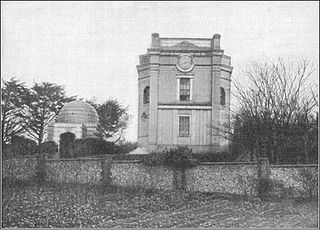
The Montefiore Synagogue is the former private synagogue of Sir Moses Montefiore. It is an 1833, Grade II* listed building in Ramsgate, Kent, England. The synagogue and mausoleum are cared for and maintained by the Montefiore Endowment. The endowment also maintains the nearby Ramsgate Jewish Cemetery.

The Włodawa Synagogue in Włodawa, Poland is an architectural complex consisting of two historic synagogues and a Jewish administrative building, now preserved as a museum. The complex includes the Włodawa Great Synagogue of 1764–74, the late 18th century Small Synagogue, and the 1928 community building. It is "one of the best-preserved" synagogues in Poland.
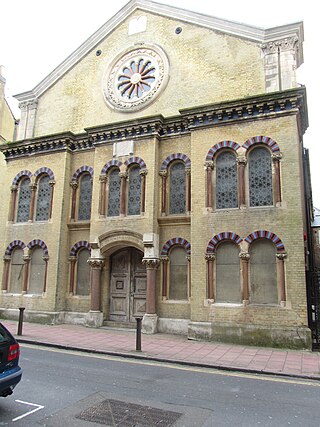
The Middle Street Synagogue is a synagogue in the centre of Brighton, part of the English city of Brighton and Hove. It was the centre for Jewish worship in Brighton and Hove for more than a century. Although it is not in full-time use, the building is still open at certain times, and cultural events frequently take place, as do weddings. It has been listed at Grade II*, reflecting its architectural and historic importance.

The Sunderland Synagogue is a former Orthodox Jewish congregation and synagogue, located on Ryhope Road, in Sunderland, Tyne and Wear, England, in the United Kingdom. The congregation was formed as the Sunderland Hebrew Congregation in 1861 and worshiped in the Ashkenazi rite until the congregation was dissolved in 2006.
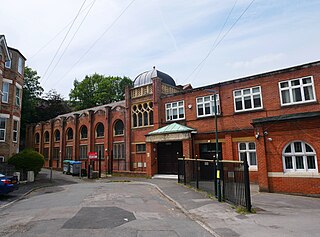
The Bournemouth Community Hebrew Congregation is an Orthodox Jewish congregation and synagogue, located in Wootton Gardens, Lansdowne, Bournemouth, Dorset, England, in the United Kingdom. The congregation was formed in 1905 and worships in the Ashkenazi rite. The rabbi of the congregation is Adrian Jesner.

The Cheltenham Synagogue is a synagogue in Cheltenham and is noted for its Regency architecture. It is an independent congregation located in the town centre on Synagogue Lane, off St James's Square.
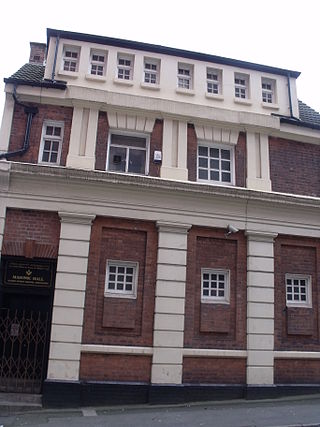
The Severn Street Synagogue is a former Orthodox Jewish congregation and synagogue, located at 60 Severn Street, Birmingham, West Midlands, England, in the United Kingdom. The congregation was founded in 1809 and worshiped in the Ashkenazi rite until the congregation was merged into the Singers Hill Synagogue congregation in 1856.

Sandy's Row Synagogue is an Orthodox Jewish congregation and synagogue, located on Sandys Row, on the corner of Middlesex Street in Bishopsgate, in the East End, Borough of Tower Hamlets, London, England, in the United Kingdom.

Merthyr Synagogue is a former Jewish synagogue located on Bryntirion Road in the Thomastown section of Merthyr Tydfil, Wales. It is a Grade II listed building and is the oldest purpose-built synagogue in existence in Wales.

Exeter Synagogue is in Synagogue Place, Mary Arches Street within the old city of Exeter, Devon, and is the third oldest synagogue in the United Kingdom. Originally built as a Sephardi synagogue for Dutch Jews trading in Exeter, it is now a synagogue of the Ashkenazi rite. Exeter Hebrew Congregation itself existed shortly prior to its construction.
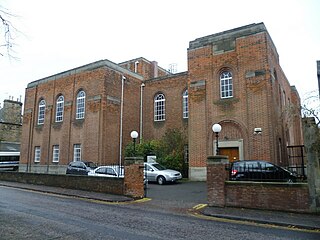
The Edinburgh Synagogue is an Orthodox Jewish congregation and synagogue, located at 4 Salisbury Road in the Newington area of Edinburgh, Scotland, in the United Kingdom. Established in 1816 as the Edinburgh Hebrew Congregation, the congregation worships in the Ashkenazi rite.

The Great Synagogue or Choral Synagogue is a former Orthodox Jewish synagogue, located on Yaroslava Mudroho Street, in Bila Tserkva, in the Kyiv Oblast of Ukraine. The synagogue was built in the former Russian Empire in 1860 and the congregation worshipped in the Ashkenazi rite.
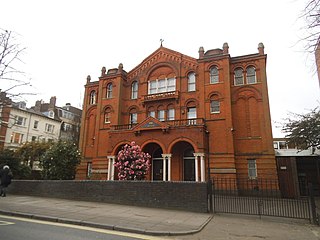
New London Synagogue is a Masorti Jewish congregation and synagogue, located in St John's Wood, in the City of Westminster, London, England, in the United Kingdom.




















